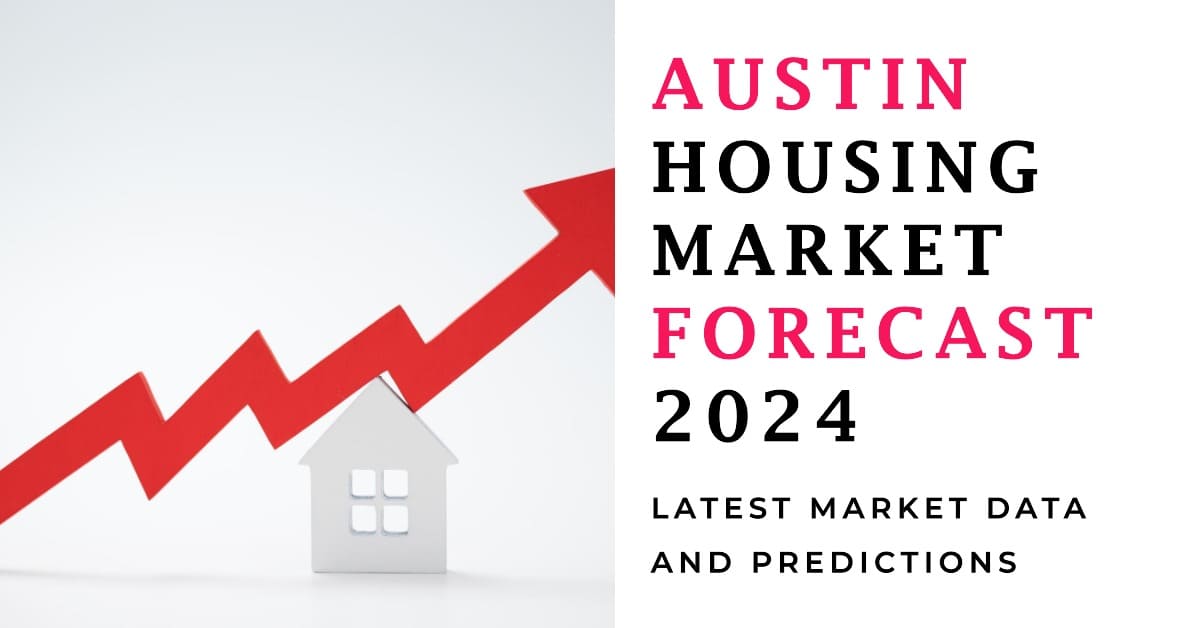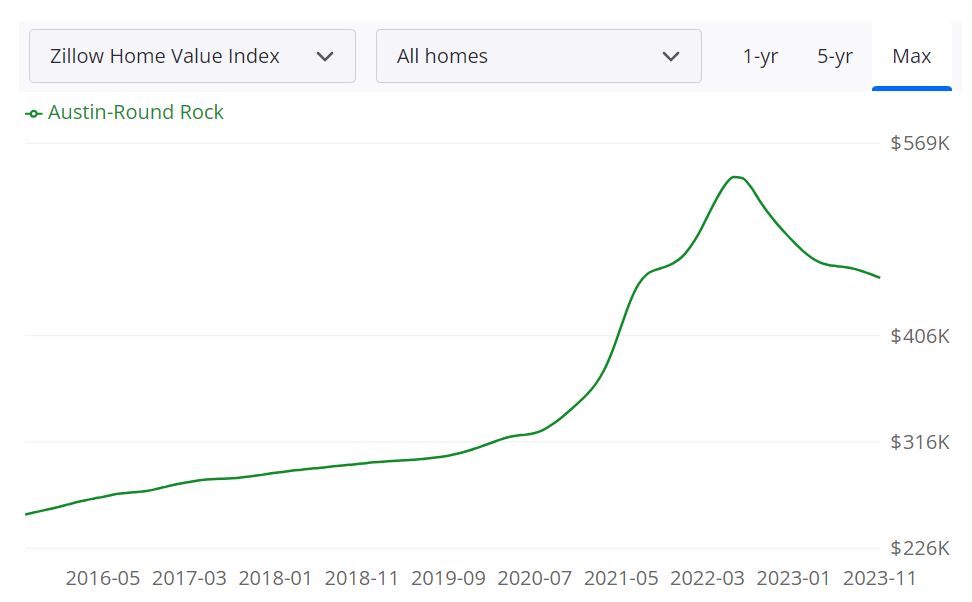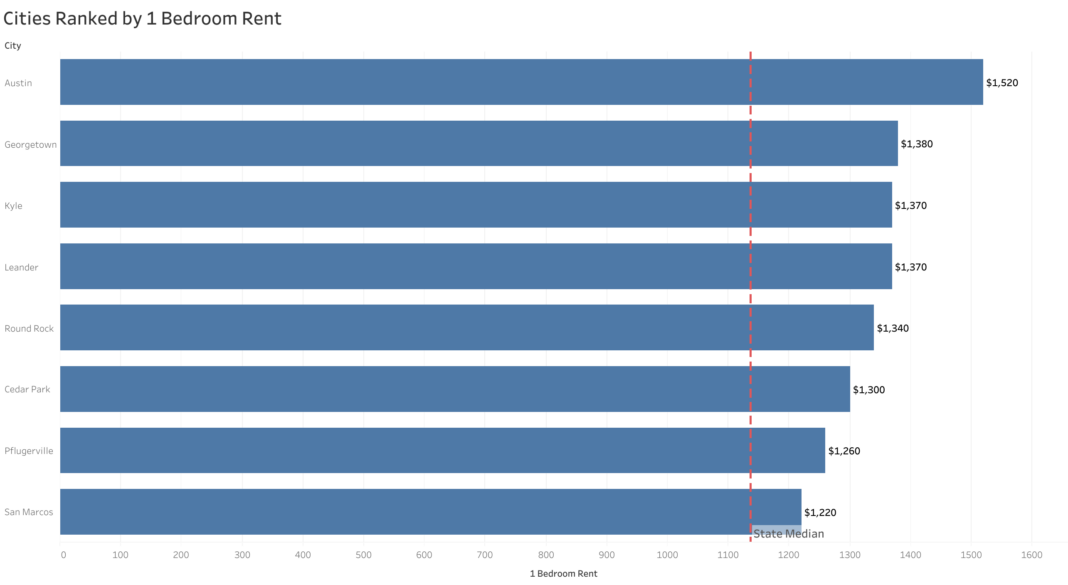


The Austin Housing Market Report for November 2023 reflects a dynamic real estate landscape with shifting trends and encouraging signs for potential homebuyers. The drop in median home prices, coupled with an increase in housing inventory, suggests a more favorable environment for buyers.
A recent report from Realtor.com has stirred the conversation by making bold predictions about the Austin housing market for 2024. The national forecast for home prices in the U.S. suggests a modest dip of 1.7% in 2024. However, what captures attention is the specific prediction for the Austin area—a substantial 12.2% drop in home prices next year.
This projection has sparked discussions among real estate experts and residents, prompting varied opinions and analyses. Contrary to the above-mentioned forecast, there could be a slight increase in Austin home prices for the upcoming year despite higher interest rates.
The interplay of factors like interest rates, buyer behavior, and creative solutions from the real estate industry will likely shape the trajectory of Austin’s real estate landscape. One thing is very clear as we approach the new year, the real estate landscape in Austin is poised for change, and whether it aligns with predictions or takes an unexpected turn remains to be seen.
How is the Austin housing market doing currently?
Home sales in Austin remain strong despite continued higher rates.
According to the Austin Board of REALTORS® November 2023 Central Texas Housing Market Report, the median home price across the Austin Round-Rock MSA dropped 8.4% to $424,450 last month. This suggests that Austin’s housing supply is becoming available at lower price points, although it remains considerably elevated relative to pre-pandemic levels. Despite higher mortgage rates, the Central Texas housing market experienced a slight increase in residential homes sold across the MSA, rising 0.2% to 2,065 total sales.
Market Trends and Insights
Impact on Buyers: “Buyers in Central Texas now have a more abundant selection of homes to peruse than in previous years,” says Ashley Jackson, the 2023 ABoR president. The drop in median home prices indicates that buyers can be more selective in the search for a home that meets their criteria. For buyers actively shopping for a home, and those waiting for the right moment, now is the time to contact your REALTOR® and get serious about buying a home.
Sales Dollar Volume and Days on Market: In November, the sales dollar volume dropped 5.7% year over year to $1,117,612,190 across the MSA. Homes spent an average of 75 days on the market, up 18 days from November 2022, indicating a shift in the pace of the market.
Inventory Dynamics: Housing inventory increased by 0.7 months to 3.7 months of inventory. New listings rose 11.6% year over year to 2,676 listings, active listings increased 7.2% year over year to 9,334 listings, and pending listings rose 9.2% year over year to 2,065 listings. This signifies a notable increase in housing options for potential buyers.
Insights from Housing Economist
Effect of Mortgage Rates: Clare Losey, Ph.D., housing economist for ABoR, noted that elevated mortgage rates are contributing to the decline in home prices and an increase in active listings as homes remain on the market for longer. “A rise in mortgage rates reduces buyers’ purchasing power, so the moderation in home prices helped to offset some of the decline in affordability. However, rates peaked in late October and early November, signaling a rise in buyers’ purchasing power moving into 2024.”
Local Initiatives and Future Outlook
Home Options for Middle-income Empowerment Initiative: The Austin City Council recently passed Phase I of the Home Options for Middle-income Empowerment initiative. This initiative aims to create more homeownership and rental options for current and future residents through a balanced approach. As ABoR and residents in the Central Texas area continue to advocate for more housing inventory and attainable housing options across the region, Losey shared that the jump in listings is an encouraging sign for buyers.
Encouraging Signs for Buyers: “The year-over-year uptick in new and active listings provides buyers with more options, which is a welcome reprieve from the starved market many have endured in recent years. While this current increase in listings gives our market some breathing room, our city should embrace opportunities to generate more housing supply,” said Clare Losey.
Detailed Analysis of Housing Trends in Key Austin Areas
City of Austin
- Residential Homes Sold: 516 residential homes were sold, reflecting a 6.0% decrease compared to November 2022.
- Median Price: The median price for residential homes in the City of Austin was $518,000, marking a 1.3% increase from November 2022.
- New Listings: There were 788 new home listings on the market, a substantial 14.7% increase from the same period last year.
- Active Listings: The market saw a notable increase with 2,747 active home listings, up by 20.4% compared to November 2022.
- Pending Sales: Despite a 3.3% decrease, there were 493 pending sales in the City of Austin.
- Months of Inventory: The months of inventory increased to 3.8, representing a 1.2 months rise from November 2022.
- Total Dollar Volume: The total dollar volume of homes sold reached $350,511,473, showing a 2.2% decrease from November 2022.
Travis County
- Residential Homes Sold: Travis County saw 840 residential homes sold, a 6.9% decrease compared to the same month in 2022.
- Median Price: The median price for residential homes in Travis County was $510,000, marking a 1.9% decrease from November 2022.
- New Listings: There were 1,240 new home listings on the market, a notable 14.2% increase from the previous year.
- Active Listings: The market experienced a 15.2% increase with 4,489 active home listings in Travis County.
- Pending Sales: Despite a 4.0% increase, there were 838 pending sales in Travis County.
- Months of Inventory: The months of inventory increased to 3.9, representing a 1.1 months rise from November 2022.
- Total Dollar Volume: The total dollar volume of homes sold in Travis County was $571,627,789, showing an 8.5% decrease from November 2022.
Williamson County
- Residential Homes Sold: Williamson County saw 697 residential homes sold, reflecting a -6.4% decrease compared to November 2022.
- Median Price: The median price for residential homes in Williamson County was $416,545, marking a 3.1% decrease from November 2022.
- New Listings: There were 818 new home listings on the market, a slight 0.4% decrease from the previous year.
- Active Listings: The market saw a 12.2% decrease with 2,587 active home listings in Williamson County.
- Pending Sales: Despite a 4.2% increase, there were 763 pending sales in Williamson County.
- Months of Inventory: The months of inventory remained the same at 3.0, compared to November 2022.
- Total Dollar Volume: The total dollar volume of homes sold in Williamson County was $322,184,052, showing an 11.7% decrease from November 2022.
Hays County
- Residential Homes Sold: Hays County experienced a significant increase with 381 residential homes sold, a 41.6% rise from November 2022.
- Median Price: The median price for residential homes in Hays County was $368,995, marking a 10.3% decrease from November 2022.
- New Listings: There were 431 new home listings on the market, a substantial 39.9% increase from the previous year.
- Active Listings: The market saw a 20.0% increase with 1,503 active home listings in Hays County.
- Pending Sales: With a 41.8% increase, there were 339 pending sales in Hays County.
- Months of Inventory: The months of inventory increased to 4.0, representing a 0.6 months rise from November 2022.
- Total Dollar Volume: The total dollar volume of homes sold in Hays County was $169,825,434, showing a 22.6% increase from November 2022.
Bastrop County
- Residential Homes Sold: Bastrop County saw 88 residential homes sold, a 17.0% decrease compared to November 2022.
- Median Price: The median price for residential homes in Bastrop County was $346,000, marking a 3.5% decrease from November 2022.
- New Listings: There were 147 new home listings on the market, a 2.1% increase from the previous year.
- Active Listings: The market saw a 12.5% increase with 566 active home listings in Bastrop County.
- Pending Sales: With a 24.7% increase, there were 96 pending sales in Bastrop County.
- Months of Inventory: The months of inventory increased to 4.7, representing a 0.8 months rise from November 2022, making it the highest inventory in the MSA.
- Total Dollar Volume: The total dollar volume of homes sold in Bastrop County was $33,671,470, showing a 24.3% decrease from November 2022.
Caldwell County
- Residential Homes Sold: Caldwell County experienced a notable increase with 59 residential homes sold, a 51.3% rise from November 2022.
- Median Price: The median price for residential homes in Caldwell County was $313,275, marking a 5.1% decrease from November 2022.
- New Listings: There were 40 new home listings on the market, a 2.6% increase from the previous year.
- Active Listings: The market saw a substantial 70.3% increase with 189 active home listings in Caldwell County.
- Pending Sales: With a 6.0% decrease, there were 29 pending sales in Caldwell County.
- Months of Inventory: The months of inventory increased to 4.3, representing a 1.7 months rise from November 2022.
- Total Dollar Volume: The total dollar volume of homes sold in Caldwell County was $19,075,593, showing a 45.6% increase from November 2022.
Conclusion and Future Outlook
The detailed analysis of housing trends across key areas in Austin reveals a diverse market landscape with varying trends in sales, pricing, and inventory levels. While some areas experienced decreases in residential homes sold and median prices, others saw significant increases, reflecting the dynamic nature of the Central Texas housing market.
As stakeholders continue to implement initiatives to address affordability and housing inventory concerns, the future outlook suggests ongoing shifts in the market. Potential homebuyers and investors should closely monitor these trends and work with real estate professionals to make informed decisions in this ever-evolving real estate landscape.
Austin Housing Market Forecast 2024
Current Market Overview: According to Zillow, the average home value in the Austin-Round Rock area stands at $455,424 as of November 30, 2023. This reflects a 9.2% decrease over the past year. Homes are going pending in approximately 55 days, providing a snapshot of the market’s current dynamics.
One-Year Market Forecast
Forecasted Trends: Zillow’s one-year market forecast, as of November 30, 2023, projects a -2.1% change. This suggests a potential continued adjustment in the housing market over the next year, influencing both buyers and sellers.
Inventory and Listings
- For Sale Inventory: The current for-sale inventory stands at 11,152 homes as of November 30, 2023, providing potential buyers with a range of options in the market.
- New Listings: In November 2023, there were 2,262 new listings, indicating ongoing activity and potential opportunities for buyers and sellers alike.
Price Dynamics
- Median Sale Price: The median sale price, as of October 31, 2023, is $458,667, providing insights into the pricing landscape within the Austin-Round Rock area.
- Median List Price: The median list price, as of November 30, 2023, is $526,600, offering a benchmark for both buyers and sellers in the market.
Sales Metrics
- Median Sale to List Ratio: The median sale to list ratio, as of October 31, 2023, is 0.980, providing a key indicator of the relationship between listing prices and actual sale prices.
- Percent of Sales Over List Price: As of October 31, 2023, 14.2% of sales were recorded over the list price, indicating competitive dynamics in the market.
- Percent of Sales Under List Price: Conversely, 68.5% of sales were recorded under the list price as of October 31, 2023, offering insights into negotiation trends.
Is Austin a Buyer’s or Seller’s Housing Market?
The current market dynamics suggest a more balanced playing field for both buyers and sellers. While the average home value has decreased over the past year, the mix of inventory, new listings, and pricing metrics indicates opportunities for both those looking to buy and those looking to sell.
Are Home Prices Dropping?
Yes, home prices in the Austin-Round Rock area have experienced a 9.2% decrease over the past year. This could be an advantageous factor for potential buyers looking for more affordable options in the market.
While the one-year market forecast suggests a -2.1% change, it doesn’t necessarily indicate a market crash. Real estate markets are influenced by various factors, and a moderate adjustment over the forecasted period is a common occurrence. It’s essential for stakeholders to monitor trends and adapt strategies accordingly.
Is Now a Good Time to Buy a House in Austin?
Given the decrease in home prices and the balanced market conditions, now could be a good time for prospective buyers to explore the housing market. The availability of inventory, coupled with the forecasted adjustments, presents opportunities for those considering a home purchase.


Is the Austin Housing Market Overpriced?
The question of whether the Austin housing market is overpriced is a subjective one and can depend on several factors. Firstly, it is important to note that the Austin housing market has been experiencing an unprecedented level of demand over the past few years. This demand has been driven by a combination of factors, including a strong local economy, a growing population, and an influx of out-of-state buyers. This increase in demand has resulted in a significant rise in the median home price.
Recent research suggests that homes in Austin continue to be among the most overvalued in the United States. The study conducted by researchers from Florida Atlantic University and Florida International University reveals that homebuyers in Austin are still paying almost 51% more than what is expected for homes. Only Boise, Idaho, has a higher premium, with homebuyers paying an exorbitant 81% more.
However, it is equally essential to compare the affordability of homes in Austin to other major cities. Although the median home price in Austin is high compared to historical norms, it is still lower than in cities like San Francisco, New York, or Los Angeles. Additionally, Austin’s cost of living is generally lower than other major cities, which can make it more feasible for some buyers to own a home.
Another aspect to consider is the potential growth of the Austin housing market. While it is impossible to predict the future, many experts believe that Austin’s robust economy and growing population make it a worthwhile long-term investment for homebuyers. Furthermore, the city has a diverse economy, making it less vulnerable to economic shocks.
Ultimately, whether or not the Austin housing market is overpriced is subjective. While some buyers may find the high prices unaffordable, others may see it as a sound investment in a thriving city. It is crucial for prospective buyers to assess their financial situation and goals before deciding to purchase a home in Austin or any other market.
Is Austin a Good Place for Real Estate Investment?
Austin’s rapidly expanding economic industry is driving more people into the city which is increasing the housing demand. A number of reasons have affected the present situation of the Austin housing market, one of which is the high migration of firms and persons relocating to the city from Texas and out-of-state, which has led to a robust and varied economy that attracts people seeking opportunity.
A surge of people moving in, combined with rapid population growth and low mortgage interest rates, has turned Austin and its surrounding area into a sellers’ market. Austin’s engine of job and population growth is not projected to slow down anytime soon—the biggest drivers of residential real estate demand. Its economy has diversified and strengthened over the past two decades.
Companies like Google and Tesla are moving operations to Austin. The software giant Oracle has also relocated its headquarters here. As more companies move here, that means more people looking for homes, and the city is also attractive to outside investors. With a steady influx of job creation in the pipeline, the housing market will continue to post strong numbers. Big companies moving here will also play into what happens to the housing market.
If you’re considering real estate investment, Austin, Texas, is a city that should be on your radar. Known for its vibrant culture, strong economy, and population growth, Austin offers numerous opportunities for real estate investors. Let’s explore in detail why Austin is a promising destination for real estate investment.
Population Growth and Trends
Population Growth:
- Austin has been experiencing consistent and substantial population growth for many years. The city’s population has been steadily increasing, making it one of the fastest-growing metropolitan areas in the United States.
- The city’s appeal to newcomers is driven by factors like its vibrant tech scene, cultural attractions, and overall quality of life.
Trends:
- The population growth trend in Austin is expected to continue, with projections indicating a significant increase in residents over the coming years.
- As the city’s population expands, the demand for housing, both rental and owned, is likely to rise, creating opportunities for real estate investors.
Economy and Jobs
Economic Strength:
- Austin’s economy is robust and diverse, with a thriving technology sector, a burgeoning startup scene, and a strong presence of major corporations.
- The city consistently ranks high in terms of job creation and economic growth, making it an attractive destination for professionals seeking employment opportunities.
Job Market:
- The city’s job market is diverse and dynamic, with a focus on technology, healthcare, education, and entertainment.
- Employment opportunities continue to draw individuals to Austin, contributing to the population growth and housing demand.
Livability and Other Factors
Livability:
- Austin consistently receives high marks for its quality of life. The city offers a vibrant cultural scene, excellent healthcare facilities, and access to outdoor activities.
- It’s known for its music and arts culture, making it a desirable place to live for professionals and creatives.
Education:
- Austin is home to top-tier educational institutions, including the University of Texas at Austin. This draws students, academics, and their families to the city, further boosting the demand for housing.
Infrastructure:
- The city has invested in infrastructure and transportation improvements to accommodate its growing population, making it more accessible and commuter-friendly.
Austin Rental Property Market Size and Growth
Rental Market:
- Austin’s rental property market is substantial and continues to grow. The city offers a wide range of rental properties, from apartments to single-family homes, catering to a diverse tenant population.
- The city’s dynamic job market attracts young professionals, making it an ideal location for rental property investment.
Zumper’s recent Austin Metro Area Rent Report delves into active listings across metro cities, revealing valuable insights into rental trends, pricing differentials, and changes in the rental landscape. The analysis, conducted last month, provides a comprehensive view of the most and least expensive cities, as well as those experiencing the fastest-growing rents in the metro area. According to the report, the Texas one-bedroom median rent stood at $1,136 last month, setting the baseline for understanding regional variations.
The best place to buy rental property is about finding growing markets. Cities like Round Rock, Cedar Park, and Pflugerville are good for investors looking to get started with rental property ownership at an affordable price. These cities look good for rental property investment this year as rents are growing over there. These trends provide a macro look at the growing rental demand. Each real estate market has its own unique supply-demand dynamics with unique neighborhoods that present their own opportunities for investors.
The Most Expensive Cities
- Austin: Topping the list as the most expensive city, Austin recorded one-bedroom rents at $1,520. This places it at the forefront of the rental market in terms of pricing.
- Georgetown: Following closely, Georgetown secured the second spot with rents at $1,380, reflecting the overall competitiveness in the region.
- Kyle: Occupying the third position in terms of pricing, Kyle registered rents at $1,370, contributing to the spectrum of pricing diversity in the Austin Metro Area.
The Least Expensive Cities
- San Marcos: Earning the title of the most affordable city, San Marcos boasted one-bedroom rents at $1,220, offering a more budget-friendly option for renters.
- Pflugerville: Securing the second spot among the least expensive, Pflugerville recorded rents at $1,260, providing renters with an affordable alternative.
- Cedar Park: While not the most affordable, Cedar Park claimed the third position with rents at $1,300, adding to the range of choices for prospective tenants.
Largest Declines in Yearly Percentage
- Cedar Park: Notably, Cedar Park experienced the largest decline in rents, falling by 13.9% since the same time last year. This significant decrease reflects changes in demand and supply dynamics within the city.
- Pflugerville: Following suit, Pflugerville recorded the second-largest decline, with rents dropping by 10.6%. This indicates a notable shift in the rental landscape over the past year.
- Austin: Austin secured the third position in terms of declines, with rents dipping by 9.5%. Despite being the most expensive city, it has witnessed a noteworthy adjustment in rental prices.


Growth Potential:
- The city’s population growth and job market strength contribute to the growth potential of the rental property market. As more people move to Austin, the demand for rental units is expected to rise.
- Investors can explore various rental strategies, including long-term leases, short-term rentals, and vacation rentals, to diversify their real estate portfolio.
Other Factors Related to Real Estate Investing
Investor-Friendly Environment:
- Austin’s business-friendly environment extends to real estate investment. The city offers attractive incentives and a favorable legal framework for real estate investors.
- Real estate investors benefit from a strong property rights regime and a well-regulated market.
Tax Benefits:
- Texas does not have a state income tax, which can be advantageous for investors looking to maximize their returns.
- Investors should explore the tax implications of specific investment strategies, including property taxes and capital gains.
Market Resilience:
- Austin’s real estate market has shown resilience during economic downturns, and it is considered one of the more stable markets in the country.
- Investors appreciate the market’s ability to weather economic fluctuations and maintain its growth trajectory.
Diversification:
- Investors can diversify their portfolios by exploring various types of real estate, from residential properties to commercial and mixed-use developments, taking advantage of Austin’s growing and diverse market.
As a real estate investor, Austin’s population growth, strong economy, livability, rental property market size, and other investor-friendly factors make it a compelling choice. However, it’s essential to conduct thorough market research, consult with local real estate experts, and tailor your investment strategy to your specific goals and risk tolerance. Austin’s real estate market offers exciting opportunities, but informed decision-making is key to success.
References:
- https://www.abor.com/new-center/market-stats
- https://www.zillow.com/austin-tx/home-values
- https://www.realtor.com/realestateandhomes-search/Austin_TX/overview
